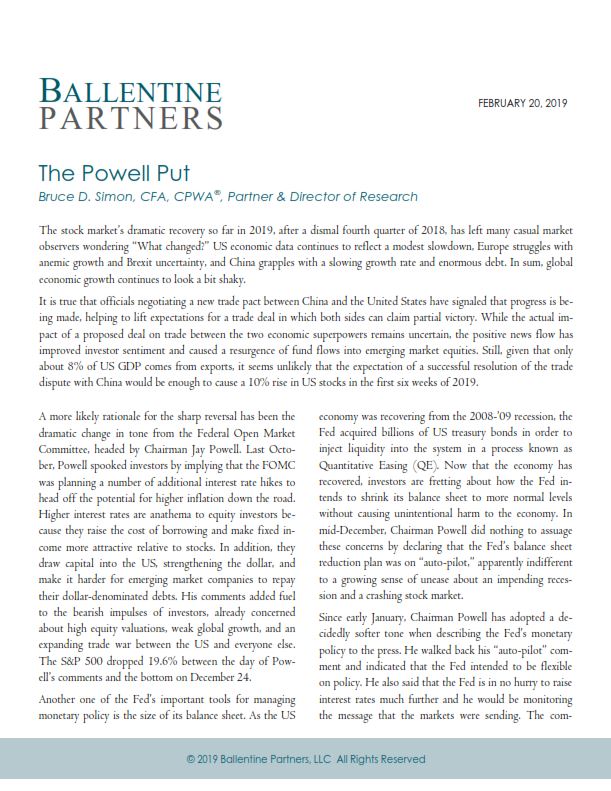 The stock market’s dramatic recovery so far in 2019, after a dismal fourth quarter of 2018, has left many casual market observers wondering “What changed?” US economic data continues to reflect a modest slowdown, Europe struggles with anemic growth and Brexit uncertainty, and China grapples with a slowing growth rate and enormous debt. In sum, global economic growth continues to look a bit shaky.
The stock market’s dramatic recovery so far in 2019, after a dismal fourth quarter of 2018, has left many casual market observers wondering “What changed?” US economic data continues to reflect a modest slowdown, Europe struggles with anemic growth and Brexit uncertainty, and China grapples with a slowing growth rate and enormous debt. In sum, global economic growth continues to look a bit shaky.
It is true that officials negotiating a new trade pact between China and the United States have signaled that progress is being made, helping to lift expectations for a trade deal in which both sides can claim partial victory. While the actual impact of a proposed deal on trade between the two economic superpowers remains uncertain, the positive news flow has improved investor sentiment and caused a resurgence of fund flows into emerging market equities. Still, given that only about 8% of US GDP comes from exports, it seems unlikely that the expectation of a successful resolution of the trade dispute with China would be enough to cause a 10% rise in US stocks in the first six weeks of 2019.
A more likely rationale for the sharp reversal has been the dramatic change in tone from the Federal Open Market Committee, headed by Chairman Jay Powell. Last October, Powell spooked investors by implying that the FOMC was planning a number of additional interest rate hikes to head off the potential for higher inflation down the road. Higher interest rates are anathema to equity investors because they raise the cost of borrowing and make fixed income more attractive relative to stocks. In addition, they draw capital into the US, strengthening the dollar, and make it harder for emerging market companies to repay their dollar-denominated debts. His comments added fuel to the bearish impulses of investors, already concerned about high equity valuations, weak global growth, and an expanding trade war between the US and everyone else. The S&P 500 dropped 19.6% between the day of Powell’s comments and the bottom on December 24.
Another one of the Fed’s important tools for managing monetary policy is the size of its balance sheet. As the US economy was recovering from the 2008-’09 recession, the Fed acquired billions of US treasury bonds in order to inject liquidity into the system in a process known as Quantitative Easing (QE). Now that the economy has recovered, investors are fretting about how the Fed intends to shrink its balance sheet to more normal levels without causing unintentional harm to the economy. In mid-December, Chairman Powell did nothing to assuage these concerns by declaring that the Fed’s balance sheet reduction plan was on “auto-pilot,” apparently indifferent to a growing sense of unease about an impending recession and a crashing stock market.
Since early January, Chairman Powell has adopted a decidedly softer tone when describing the Fed’s monetary policy to the press. He walked back his “auto-pilot” comment and indicated that the Fed intended to be flexible on policy. He also said that the Fed is in no hurry to raise interest rates much further and he would be monitoring the message that the markets were sending. The comments sparked a sharp rally in equity and bond markets which has continued through the first part of 2019. Some market observers now believe that the next move by the Fed may be a rate cut, rather than another hike.
The change in tone has led some observers to identify a phenomenon called the “Powell Put” (a throwback to the “Greenspan Put”), which implies that any serious market weakness would be offset by the Fed’s aggressive actions to mitigate the damage by easing monetary policy. Although the Fed’s official mandate does not include protecting stock market investors from losing money, the notion that he and other members of the FOMC are listening to the market’s message is a clear positive. Having raised rates nine times since the start of this tightening cycle, the Fed is much better equipped to ease policy if the economy weakens. While nothing is certain, Powell’s recent comments should provide investors with additional comfort that the Fed has their backs.
Learn more about Bruce Simon, our Director of Research.
This report is the confidential work product of Ballentine Partners. Unauthorized distribution of this material is strictly prohibited.
The information in this report is deemed to be reliable but has not been independently verified. Some of the conclusions in this report are intended to be generalizations. The specific circumstances of an individual’s situation may require advice that is different from that reflected in this report. Furthermore, the advice reflected in this report is based on our opinion, and our opinion may change as new information becomes available.
Nothing in this presentation should be construed as an offer to sell or a solicitation of an offer to buy any securities. You should read the prospectus or offering memo before making any investment. You are solely responsible for any decision to invest in a private offering.
The investment recommendations contained in this document may not prove to be profitable, and the actual performance of any investment may not be as favorable as the expectations that are expressed in this document. There is no guarantee that the past performance of any investment will continue in the future.





